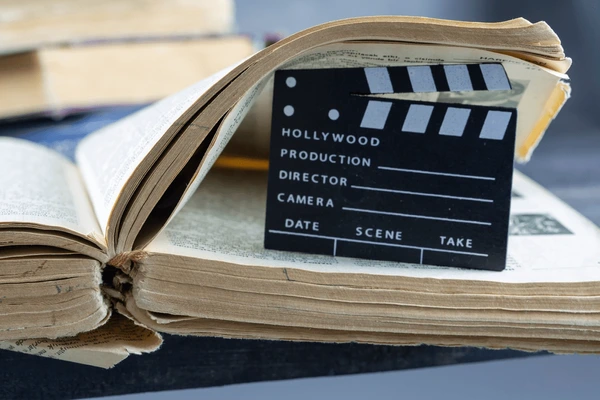When it comes to book adaptations, most people are quick to say “The book is always better!” Although this tends to be true, it’s not always the case. Adaptations are a tricky business, and there are no foolproof tricks to ensure the end product is perfect, though there are methods writers can utilize.
An adaptation needs to sprinkle information throughout so that the viewer is never overwhelmed or reminded that they are watching a film. Immersion is key to a novel, so it must be felt in an adaptation.
A properly executed adaptation needs to have respect for the readers and the new audience they hope to create. What is changed or cut from the source material needs to have purpose, as does any additions.
3 Books That Were Improved Onscreen
1) The Vampire Diaries by L. J. Smith
From 2009 to 2017, The Vampire Diaries show ruled the CW. It was the peak of vampire mania and for many, the thought of having two hot vampire brothers fighting over you was the climax of romance. It’s hard to remember that The Vampire Diaries books began in 1991, predating Twilight. The books set some of the groundwork the TV series would use, but the two stories are pretty much independent of each other. Many of the characters are altered, particularly the protagonist Elena Gilbert, who goes from a queen bee type to a more introspective loner mourning the death of her parents. The show also improves upon the lackluster climaxes of the novels, and the dialogue is substantially better.
2) Diary of a Wimpy Kid by Jeff Kinney
As the name suggests, the book follows a strict diary form, which causes it to suffer somewhat from a lack of plot. The entries are tangentially related, but struggle to weave a strong narrative. The films manage to use the themes present in the novels and intensify them, using the vignettes to highlight the main challenge faced by our protagonist Greg Heffley.
3) Cloudy With a Chance of Meatballs by Judi Barrett
It feels a bit unfair to compare a picture book for elementary schoolers to a 130 minute feature film. The book itself is a fun read for children but the movie shines by creating main characters to focus on and a plot that is easily followed, complete with a hero’s journey. While many film adaptations of beloved books fail due to overindulging and adding too much to a story, this one benefits significantly from the added portions which make up about 95% of the film.
3 Books That Were Better in the Written Form
1) Frankenstein by Mary Shelley
Cinema has done wonders in its over 100 year history, but it has not improved Mary Shelley’s 1818 masterclass in Gothic horror. A lot of the novel’s meat is in Shelley’s prose, which is not easily translated into film. Most adaptations hyper focus on Frankenstein’s monster coming to life and wreaking havoc, without exploring the themes of man’s ambition at the downfall of morality, preferring instead to do “Monster kills people. People chase him with pitchforks.”
2) Pretty Little Liars by Sara Shepard
If you were alive in the 2010s you knew about ABC Family’s Pretty Little Liars, a show about four teenage girls who are stalked by a seemingly omnipotent figure called ‘A,’ all while trying to unravel the mystery surrounding their fifth best friend’s disappearance. The show began by adapting the first eight books into the first two seasons, which worked pretty well until they started to go off book for the rest of the show. As the show progressed, it became obvious that the multitude of mysteries the show urged the audience to try to solve along with the characters had no answers planned.
3) Allegiant by Veronica Roth
Allegiant’s predecessors Divergent and Insurgent were okay films, with the latter leaning towards bad due to the decision to make the protagonist Tris Prior a cliche chosen one (which she wasn’t in the books). But nothing could have prepared us for the disaster that was Allegiant. The book it’s based on is no masterpiece, with a revelation that brought on more questions than it sought to answer, but the film was significantly worse. The Hollywood executives made a terrible decision at the onset by deciding to split the book into two films, a la The Hunger Games. Unfortunately for the makers of Allegiant, the book doesn’t really have two split halves capable of filling out a combined 4 hour run-time, forcing the movie to meander through the plot until they reached the unsatisfying climax that is only in place to get the audience excited to come back for the sequel. When the film failed to make the cash the studio expected, part two was pitched as a TV film but lead Shailene Woodley dropped out of the project, effectively ending any possible continuation.
It’s clear the adaptation is not an exact science. What a person gets out of an adaptation and its source material is subjective, though most people can agree on what causes an adaptation to fail.
Did my list strike a nerve? Which ones did I miss? Let me know in the comments.
Meet the blogger: ANNA FRYDENLUND is a senior at Hamline University where she is majoring in creative writing. In her free time, she talks through movies as she critiques them, annoying everyone around her.
ANNA FRYDENLUND is a senior at Hamline University where she is majoring in creative writing. In her free time, she talks through movies as she critiques them, annoying everyone around her.


